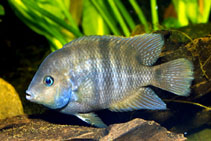| Family: |
Cichlidae (Cichlids), subfamily: Cichlasomatinae |
| Max. size: |
9 cm SL (male/unsexed); 8 cm TL (female) |
| Environment: |
benthopelagic; freshwater; pH range: 7; dH range: 15 |
| Distribution: |
Central America: Pacific slope of Costa Rica. |
| Diagnosis: |
Dorsal spines (total): 17-18; Dorsal soft rays (total): 9-10; Anal spines: 6-8; Anal soft rays: 7-8. This species has no unique autapomorphies, the third (main) lateral bar uniformly wide (its width not uniform in other species); caudal blotch usually absent; no lateral spot or medial intensification of bars on side of body; absence of ocellus on dorsal fin; without abdominal blackening in mature females; palatine arms subequal; posteriad projection on ventroposterior angle of retroarticular
absent; articular with a right angle ventrally; an anteriorly directed pronounced convexity
on ventral process of articular present; anal-fin spines modally 7 (Ref. 74403). |
| Biology: |
Inhabits rivers and rivulets which have moderate to strong currents but is not found in the rapids. Prefers smaller rocks and gravel. Found up to 2000 feet of elevation. Omnivorous, feeding on algal filaments, aquatic insects, seeds and bottom detritus. Spawns in caves or crevices, preferring to adhere its eggs to an oblique or vertical surface. Produces about 200 offspring which feed on the parent's dermal mucus. |
| IUCN Red List Status: |
Vulnerable (VU); Date assessed: 21 September 2019 (B1ab(iii)) Ref. (130435)
|
| Threat to humans: |
harmless |
Source and more info: www.fishbase.org. For personal, classroom, and other internal use only. Not for publication.

